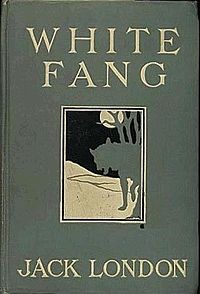“White Fang” is a classic 1906 novel by American author Jack London. The eponymous character, through whose eyes most of the action is seen, is three parts wolf, one part dog, and all parts extraordinary.
For some reason, however, the story begins long before White Fang is even born. Back in the day, writers would make a little extra coin by submitting short stories to magazines, either cribbed from a work in progress, or later adapted for inclusion into a novel or serial. This is likely to blame for the strange introduction in “White Fang”. The book was first published as a magazine serial; the first section likely began as its own story and was shoehorned into the novel so as to increase the word count and hook the magazine’s audience on the story, getting London more money and making people eager for the next installment.
The first three chapters focus on a pair of doomed prospectors and a corpse, none of whose history is ever revealed. The men are pursued by a pack of hungry wolves, and after their abrupt departure from the story, focus shifts to the wolves – in particular, a special “she-wolf” who ends up being White Fang’s mother. The canine protagonist himself does not show up until Chapter Five, nearly a third of the way into the book.
From here the story follows White Fang from his birth in the wild, through a famine, and into the possession of man. This section starts out fascinating, but rapidly descends into a laundry list of all the horrible things that happen to White Fang. For any animal lover, this is enraging and painful to read. Starting with the deaths of his father and siblings during the famine, White Fang’s life is one long train of tragedy, most of it inflicted by humans. The people in this book are sadistic to the extreme. London tries to make it clear that there are reasons for this – drunkenness, culture, a bad upbringing – but the temptation to put down the novel will be strong at this point.
Persevere, however! Because after all of that awfulness lies a redemption, and the story has a happy ending. It will make the reader want to run out and get a wolf-dog (a bad idea for all but the very best-prepared), because White Fang is a wolf-dog, and obviously there is no better dog on the planet.
Despite its slow start, the novel has genuine emotional impact, and the ending is powerful and well worth the struggle to reach it. A clear allegory is drawn between White Fang’s rehabilitation and the opposite response on the part of many humans throughout the novel, who use their various miseries and challenges as excuses for cruelty, violence, cowardice, and the like. London’s message seems to be that kindness can heal even the deepest and most abiding of injuries; had the humans in the story met with someone willing to look past their brutal, ugly exteriors to the person within, perhaps they, too, could have been repaired.
A final point, which contains spoilers. There is an informal literary term used to refer to characters portrayed as particularly special, a “Mary Sue”. Sues are superior to their peers in looks, intelligence, fighting prowess, and generally every attribute available. They are often outcasts or the only one of their kind, and frequently possess a tragic past. Though “White Fang”‘s publication precedes the advent of this term by some seventy years or more, White Fang is, undeniably, a Mary Sue. He is the bravest of his siblings, essentially an orphan thanks to the rejection of his mother; he is bullied mercilessly by the humans and by other dogs alike. He is the ultimate fighter, smarter and tougher than anyone else out there, a wolf in a dogs’ world. His life is unbelievably sad, but he is miraculously rescued and led back from the dark side thanks to the power of friendship. He then is the perfect pet: more loyal than any dog, more beautiful and more beloved, and he saves the life of his owner not once, but twice – in one instance by alerting the owner’s family to an incident by barking (even though he had never barked before and never barks again) and in the other by singlehandedly stopping a violent killer. Those who dislike him either suffer an ignominious fate or come to love White Fang in the end. These are all traits of a phenotypical Mary Sue.
White Fang’s Mary Sue tendencies do not detract from the book, however. This is a good quick read for a plane flight or a camping trip. It might even bring a tear to the unsuspecting reader’s eyes. Best of all, like most old classics, it is available for free online from Project Gutenberg at http://www.gutenberg.org/ebooks/910.


'White Fang' has no comments
Be the first to comment this post!